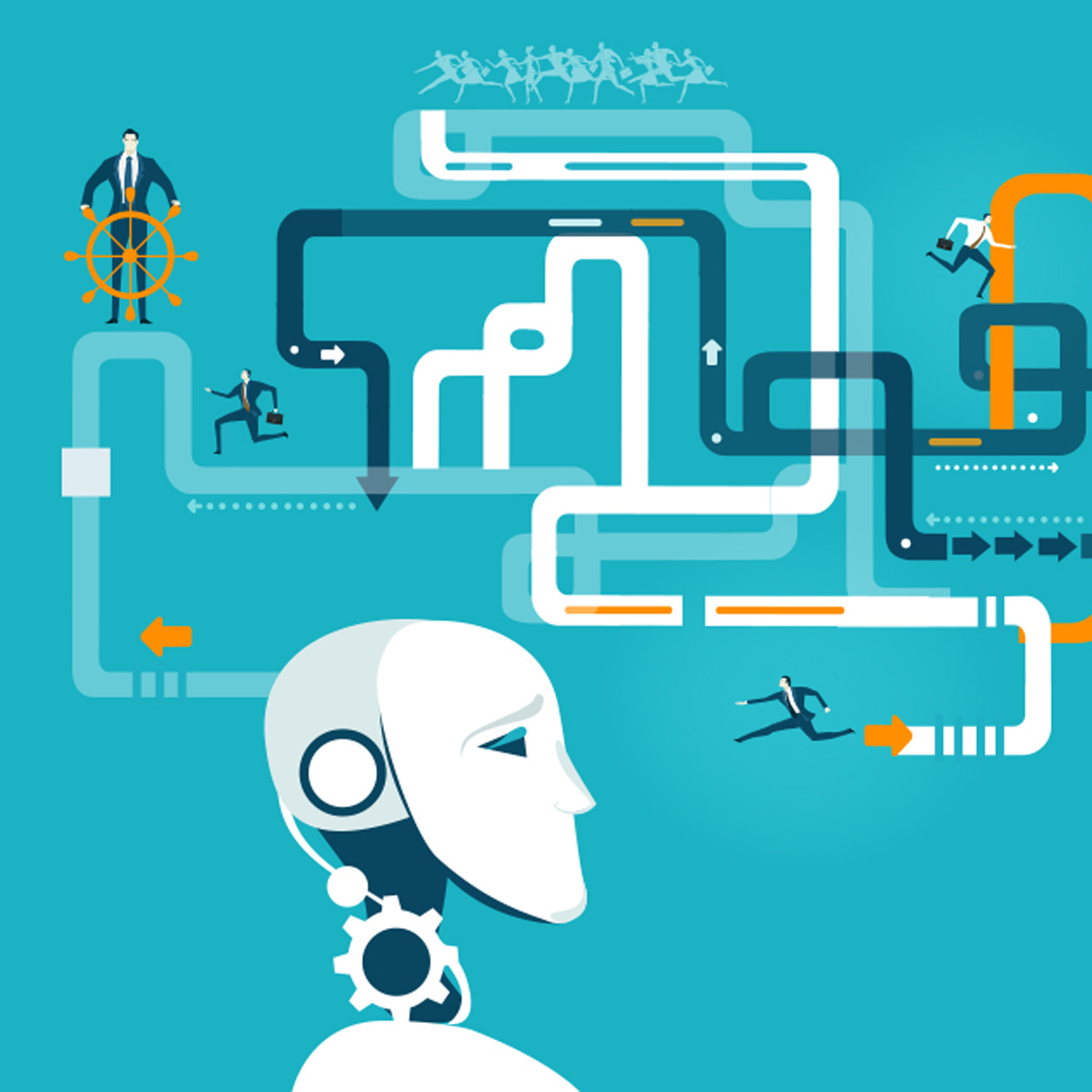

Artificial intelligence (AI) and machine learning (ML) are the two most hyped trends that are expected to disrupt many professions. As marketing leaders we’re expected to be the early adopters of everything new that comes out. On top of that, the role of agencies is changing rapidly, to such an extent that the days of some professions within marketing are numbered! No one needs armies of campaign managers, as humans are easily outperformed by Google or Facebook algorithms.
What’s next
Are all marketing activities going to be replaced by algorithms at some point? Let’s look into the future of marketing. What do we need to do to better prepare ourselves for the AI & ML disruption in marketing?
New era makes AI/ML accessible to non-scientists
In the last two decades data analytics has changed the way we conduct marketing. A prime example of this are the advertising networks that process huge data sets to make the ads more relevant and profitable for advertisers. These developments were led by large corporations and a relatively small groups of data scientists. If you weren’t the data nerd, you couldn’t participate, but naturally would benefit from easier access to the tools and insights that were created as a result. The point is though, that it was exclusive.
We’re now entering another era. Multiple AI & ML libraries make the tools more accessible, even to those with relatively basic skills can take advantage of the powerful data-driven methods. It’s a given that we will be applying AI/ML based algorithms more and more to improve how we conduct our business and what we recommend to our customers. Less and less human intervention is needed. We’re at the beginning of this journey and this article is just a start to indicate some early use cases where marketers can benefit from AI or ML already or in the near future. This is not an exclusive list, just my opinion and attempt to make sense of various facets of AI/ML in marketing.
1 – Recommendation engines for e-commerce & content sites
Recommendation engines are one of the most common applications of data science. Some systems rely on simple rules, whilst more sophisticated systems use machine learning and improve over time. These systems are used in a wide range of domains, including e-commerce (e.g. product recommendations) and media (e.g. content recommendations). Machine learning algorithms in recommendation systems are typically classified into two categories:
- Content-based methods use attributes of items and users and recommend items similar to those liked by the user in the past.
- Collaborative filtering methods recommend content liked by similar users.
More complex systems will use both methods, but complex applications are rare and dominated by large companies. I can imagine that 80/20 rule applies here and even smaller sites can get the majority of benefits by implementing more one-sided and simpler methods to recommend content or products. There is even a WordPress plugin for Woocommerce shops that offers this powerful functionality, so this is already happening.
2 – Predictive analytics in campaign management & CRM
Applying machine learning and other statistical techniques to predict the future. This can be particularly useful in customer communication planning and campaign planning, especially when dealing with a large database of customers.
Churn analysis
For instance, conducting so-called churn analysis (attrition modelling). Existing customers are one of the most valuable assets of every business, therefore a predictive analytics model can be built to prevent good customers from switching. This is a valuable tool allowing to catch people who are thinking of terminating their subscription or switching to another product.
Campaign management
Scientific models used by large advertising networks (e.g. Google, Facebook) use predictive analytics to determine which users are more likely to engage or purchase. As marketers we can now rely on campaign optimisation algorithms that automatically set campaign parameters to achieve the campaign goal (i.e. sale or traffic). Those algorithms were pretty basic 10 years ago and today, CPA or ROAS based campaign goals are now our daily business. Modern ad networks can also dynamically create advertising content and adjust it on the fly to users’ preferences, which saves a lot of time and money that used to be invested in banner campaign management, creation of assets, resizing etc.
Other common use cases are lead scoring, prediction of customer life-time value (CLTV), pricing optimisation and forecasting.
3 – Image recognition in creative content on social media
There is a strong case for image recognition applications in measurement of social media mentions and engagement, specifically companies looking for their product or logo to appear on social media, e.g. Nike wants to know how many people show off their new sneakers on social media. This could be invaluable information to evaluate large awareness campaigns that don’t have any direct calls to action (e.g. sponsorships, TV, press etc.).
Filtering social media content
One underestimated function of AI/ML is simple filtering of social media content. Instagram and other social media offer basic tools to browse content and understand the characteristics of what’s posted. On Instagram you can easily search by hashtags, location or user – it’s pretty useless when you want to find all posts in a certain location that show a picture of a dog, or you want to understand what objects are more likely to appear under a certain hashtag.
More engaging social media content
Another application of AI that is perhaps less established is content production and image selection. As marketers we need to develop a ‘good eye’ for design or creativity to know what images will “make people tick” online. As the content delivery algorithms on social media and websites are mostly driven by complex AI calculations, it makes sense to use similar tools to understand what content works and what doesn’t. Thanks to new tools we can support our opinions with data and hard facts, which will allow us to make better decisions, e.g. what objects or locations receive more engagement in the context of my product, who are the celebrities with the highest engagement in my product category etc. Those are data nuggets that can be directly applied in campaigns and content production and will help us avoid making fundamental mistakes when selecting the right images.
These types of techniques will soon be extended to video, which will make it even more interesting.
4 – Advisory tasks automation and insights
Our actions as growth hackers or marketing advisors can be well structured and we often find ourselves conducting the same task over and over again, just for another website. In cases, such as keyword analysis, website audit or campaign review, we are limited by the amount of data one can process and our time is also strictly limited. Everyone who cares about scalability of their advisory practice dreams of a machine that can do this type of job.
Poor Ali AI (for now at least!)
I’ve tested Ali AI, one of the SEO tools, allegedly using AI to provide recommendations. The tool is easy to use and well structured, divided into onpage, onsite, outreach and task sections. As for the content and recommendations Ali AI is pretty useless. Ali AI didn’t appreciate the existing performance of the site and simply recommended to change headings on the homepage to one of the focus keywords – other recommendations were also pretty high-level. The trial was done on a website that’s already quite advanced in their SEO and if I followed Ali AI, I would be destroying the results of the last year of the optimisation work. Ali AI seems to be more of an automation tool for SEO processes rather than an AI based engine for accurate recommendations. I think with some manual intervention and improvements to the algorithm it could be quite useful, but at the moment I wouldn’t rely on its engine.
Using AI/ML as complementary tools
Growth hacking or marketing advisory is a complex task, one has to study various sources, consider technical & fixed aspects as well as the product knowledge and creativity. I see the role of AI in the advisory role more as a complementary tool, used by humans who understand how and when to defer to AI-based machines to get insights needed for the main task, e.g. humans can sign-off the recommendations done by Google’s advertising algorithm. In this sense the AI algorithm provides micro-insights and the human has the overall vision for the campaign.
Linking various insights
In the next ten years I see little chance for AI to conduct similar complex assessments that we conduct on a daily basis. In those assessments there are small quantities of data from a number of changing sources involved. There is naturally a lot of value in using data and perhaps even AI to gather micro-insights that will inform the broader strategy. I can imagine giving a small mandate to AI based algorithms to answer specific questions. This is already becoming a part of our daily operations (e.g. identifying lookalike audiences or optimising campaigns). On their own these micro-insights aren’t useful, but combined with knowledge and other sources of information, they become powerful.
5 – Natural Language Processing (NLP)
NLP algorithms extract meaning from text to understand human language, interpret and converse with it. NLP takes into account the form of input (speech or voice).
Customer service chatbots
Sales or customer service chatbots, equipped with NLP technology, are able to understand conversations and answer their questions or direct them to relevant content. Already today, chatbots can be easily confused with humans.
Sentiment analysis
Using sentiment analysis also helps to analyse conversations and measure satisfaction levels. Most of these NLP applications use statistical methods that are able to simulate what a human would do in similar circumstances. We all already profit from NLP algorithms when we search or use translation services.
Content creation
We already heavily rely on translation engines to save time when creating and translating existing content, but I’m particularly excited about AI application together with NLP to create new content. Although the results of early experiments are impressive, the fact that I’m writing this text manually only proves the point that it’s still early days! Recently OpenAI (https://openai.com/) previewed a collection of AI models that can generate coherent text given words or sentences. These types of advancements will have a big impact on copywriters and all kind of content marketing. When a quality text on the most common subjects can be created by machines within seconds, it will create even more volumes of content. As these algorithms learn and improve it should raise the bar for all content producers out there.
6 – Psychographic personas
On top of demographic data, which (like it or not) is now easily accessible, we can use psychographic segmentation to group prospective, current or previous customers by their shared personality traits, beliefs, values, attitudes, interests, and lifestyles and other factors. Although it seems more like a ‘data source’ I thought that psychographic personas deserves a mention in this article. This type of data is difficult and perhaps controversial to gather, but it’s a growing trend and will receive more and more attention in the future.
Your use cases
I’m curious to hear about your AI/ML applications and your feedback. I’m always keen to test new tools so if you have any recommendations please let me know.